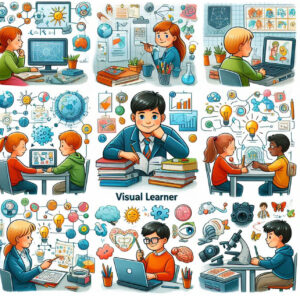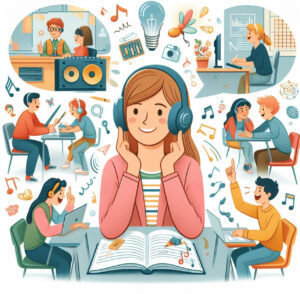Welcome Blessings!
(Tap 🔽 to see more topics!)


Strategies for teaching should recognize that each student has unique strengths, much like how a bird excels in the sky and a fish thrives underwater. Have you ever looked at a bird and thought, “That bird is pretty dumb for being unable to swim”? Or have you seen a fish and judged it as “stupid” because it can’t fly? It might sound ridiculous.
Each of these creatures has its unique strengths. They don’t need to be able to do the other’s job to succeed at what they do best. The same logic applies to students or even employees. Like animals, humans have different ways of processing and learning new information. That’s why it’s essential to recognize and understand their diverse learning styles and what strategies we can use to help them best.
Recognizing these differences is critical to delivering effective and engaging lessons. Learning styles influence how students absorb information, interact with peers, and express their understanding. In this article, we’ll talk about teaching strategies that address these differences, focusing on the VARK model—visual, Aural, Reading/Writing, and Kinesthetic—and providing tips for each.
Imagine trying to teach a fish how to fly. No matter how hard you try, you won’t succeed unless you acknowledge that fish are made for swimming, not soaring through the sky. The same goes for students (and actually employees). Teaching strategies that work for one may not work for another. Understanding different learning styles and techniques is essential for effective teaching. Just like we embrace diversity in nature, we must also embrace the diversity of learning preferences in our classrooms and working environment.
Students don’t always fit neatly into one category. Some might have a preference for one style, while others might blend multiple styles. Therefore, it’s essential to use various teaching methods to create an environment where all students can thrive. By recognizing each student’s unique preferences, we can meet their individual needs and set them up for success.
(Seeing is Believing)
Visual learners understand and remember information better when they can see it. They enjoy looking at charts, diagrams, and colorful images to grasp new concepts. Just like a picture can speak a thousand words, these students retain information more effectively when represented visually.
Characteristics:
Teaching Strategies:

(Hear, Absorb, Repeat)
Aural learners are auditory learners. They learn best through sound, including music, rhythm, and spoken words. These learners can often remember information by listening to it, whether it’s through lectures, podcasts, or discussions.
Characteristics:

Teaching strategies:
For aural learners, use storytelling, verbal explanations, and discussions. Please encourage them to participate in debates, presentations, or group discussions to reinforce their learning. You can even introduce rhythmic chants or catchy songs to help them memorize concepts. Just like a musician who memorizes notes by listening, aural learners thrive when information is presented verbally or through sound.
(The Power of Words)
Learners inclined towards reading and writing learn best through these activities because they are all about the written words. Individuals with solid linguistic skills often prefer learning and communicating through the written word. They have a knack for using language effectively, so their vocabulary is extensive. These students are usually voracious readers and writers. They process information best when reading about it or writing notes to reinforce their understanding. For them, language is a powerful tool for learning.
Characteristics:

Teaching strategies:
(Learning Through Movement)
This type of learner thrives best by doing. Mostly, individuals in this type of learning prefer physical activities, hands-on tasks, experiments, and simulations to understand and apply information. Also, they have a good sense of balance and coordination. These learners must move around, touch things, and actively participate in learning. Physical activities and simulations are their best allies when understanding new concepts.
Characteristics:

Teaching strategies:
We’ve talked about how every student learns a little differently. It’s like planning a potluck – you wouldn’t just bring one dish and expect everyone to be happy. You’d want various options to ensure everyone finds something they like. That’s how we need to think about teaching too. We need to offer a mix of visual aids, hands-on activities, and opportunities for listening and discussion to reach all our students.
Learning styles aren’t set in stone. Sometimes, students learn best by seeing diagrams. Others prefer to listen to a lecture. Sometimes, they must get their hands dirty and build something. Kids change, topics change, and their preferred learning styles can change, too. So, we must be flexible and offer different ways to learn. Think of it as having a toolbox of other tools – you choose the right one for the job.
Just like a bird is meant to fly and a fish is meant to swim, each student has unique talents and ways of learning. When we recognize those differences and adapt our teaching, we create a classroom where everyone feels supported and can shine. Understanding learning styles – like the VARK model (Visual, Aural, Reading/Writing, and Kinesthetic) – gives us a roadmap for reaching each student and helping them reach their full potential.
It isn’t just about teaching techniques. It’s about connecting with our students on a deeper level. In addition, it’s about creating a classroom where everyone feels seen, heard, and understood. It’s about moving away from that old “one-size-fits-all” mentality and embracing the beautiful diversity of learners. Whether they’re budding artists, gifted writers, or hands-on builders, we can equip them with the tools they need to succeed.
Next time you plan a lesson, think about those different learning styles. How can you incorporate a variety of approaches to reach every student? Try something new, experiment, and see what works best. Share your experiences and ideas in the comments below. I’d love to hear what you’re doing in your classrooms. Let’s learn from each other and create exceptional learning experiences for all our students. Voila! Until next time!
Additional References:
WGU Hey Teach. 2020, November 18. Accommodating different learning styles: 3 tips to guide you. https://www.wgu.edu/heyteach/article/accommodating-different-learning-styles-3-tips-guide-you-01702.html
Virtual Speech. 2020, October 29. Teaching strategies for the 8 different learning styles. https://virtualspeech.com/blog/teaching-strategies-different-learning-styles
Resilient Educator. n.d. Teaching styles: Different teaching methods & strategies. https://resilienteducator.com/classroom-resources/5-types-of-classroom-teaching-styles/